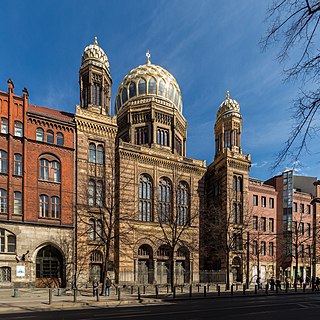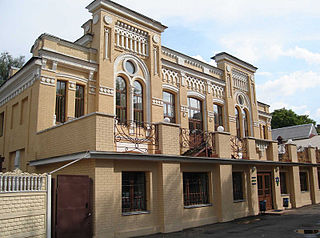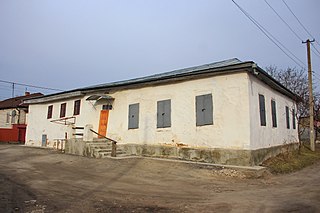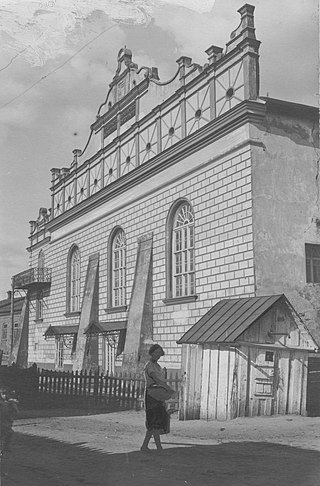

The synagogue in Sharhorod in Ukraine, Vinnytsia Oblast was built in 1589 and is one of the oldest synagogues in Ukraine.


The synagogue in Sharhorod in Ukraine, Vinnytsia Oblast was built in 1589 and is one of the oldest synagogues in Ukraine.
The synagogue was built in 1589 as a fortress synagogue with walls between 1 and 2 m thick. [1] The square main hall, which measures 15 x 15 m was the prayer hall the men. To the north is an extension which was the prayer hall for women. There are further extensions along the walls, of which the ones to the south and east are fairly modern (around 1950). [2] Inside the main hall are 4 pillars, which are decorated with ornamental stucco fragments of the 18th and 19th centuries. [3]
Sharhorod was occupied by the Turks between 1674 and 1699. [4] During this time the synagogue was used as a mosque. After the Turks were driven out of the region, it was converted into a synagogue again.
From around 1930, when Ukraine (and Sharhorod) belonged to the Soviet Union, the building was used as a storehouse for beverages.
In 2012 it was returned to the small Jewish community of Sharhorod. [5]

A synagogue, also called a shul or a temple, is a place of worship for Jews and Samaritans. It has a place for prayer where Jews attend religious services or special ceremonies such as weddings, b'nai mitzvah, choir performances, and children's plays. They also have rooms for study, social halls, administrative and charitable offices, classrooms for religious and Hebrew studies, and many places to sit and congregate. They often display commemorative, historic, or modern artwork alongside items of Jewish historical significance or history about the synagogue itself.

The New Synagogue on Oranienburger Straße in Berlin is a mid-19th century synagogue built as the main place of worship for the city's Jewish community, succeeding the Old Synagogue which the community outgrew. Because of its eastern Moorish style and resemblance to the Alhambra, the New Synagogue is an important architectural monument in Germany.

Sharhorod, also known as Shargorod, is a small city located within the Vinnytsia Oblast, Ukraine. It served as the administrative center of the former Sharhorod Raion until its dissolution in 2020. Population: 6,982.

Moorish architecture is a style within Islamic architecture which developed in the western Islamic world, including al-Andalus and what is now Morocco, Algeria, and Tunisia. Scholarly references on Islamic architecture often refer to this architectural tradition in terms such as architecture of the Islamic West or architecture of the Western Islamic lands. The use of the term "Moorish" comes from the historical Western European designation of the Muslim inhabitants of these regions as "Moors". Some references on Islamic art and architecture consider this term to be outdated or contested.

The Jāmeh Mosque of Isfahān or Jāme' Mosque of Isfahān, also known as the Atiq Mosque and the Friday Mosque of Isfahān, is a historic congregational mosque (Jāmeh) of Isfahan, Iran. The mosque is the result of continual construction, reconstruction, additions and renovations on the site from around 771 to the end of the 20th century. The Grand Bazaar of Isfahan can be found towards the southwest wing of the mosque. It has been a UNESCO World Heritage Site since 2012. It is one of the largest and most important monuments of Islamic architecture in Iran.

The Ramban Synagogue is the second oldest active synagogue in the Old City of Jerusalem, after only the Karaite Synagogue. It dates back in its current location to sometime around 1400. Tradition holds that as an institution, it was founded by the scholar and rabbi Moshe ben Nachman, also known as Nachmanides or Ramban, in 1267, but at a more southerly location on Mount Zion, to help rebuild the local Jewish community, which indeed expanded because of the synagogue's presence. The synagogue was moved to its current location around 1400, where it was destroyed in 1474, rebuilt in 1475, and continued functioning until being closed by the Muslim authorities in the late 16th century. The building was used for industrial and commercial purposes until its destruction in the 1948 Jordanian siege of the Jewish Quarter. After the 1967 Six-Day War, it was rebuilt over the old ruins and reconsecrated as a synagogue.

The Halytska Synagogue is a synagogue in Kyiv, Ukraine.

The Tsori Gilod Synagogue is the only functioning Jewish Orthodox synagogue in Lviv, Ukraine.

The Jakob Glanzer Shul, also called the Chasidim Synagogue, is a former Orthodox Hasidic Jewish synagogue, located at Vuhil'na (Coal) Street Nr.3 in Lviv, Ukraine. The building operated as a synagogue from 1844 until 1962; had various uses during World War II and Soviet occupation; before being preserved as a Jewish history museum and cultural center since 1995.

The Golden Rose Synagogue, known also as the Nachmanowicz Synagogue, or the Turei Zahav Synagogue was an Orthodox Jewish synagogue, located in Lviv, in what is now the Lviv Oblast in western Ukraine. The Golden Rose Synagogue, established in 1582 in the Polish–Lithuanian Commonwealth, was the oldest synagogue in what is now Ukraine. From September 1603 until 1801, the Golden Rose served as the main communal synagogue while the Great City Synagogue expanded its facilities. Both the Golden Rose and Great City synagogues were destroyed by Nazis during World War II.

The Synagogue in Chachmei Lublin Yeshiva is a synagogue located in Lublin, Poland, in the building of Chachmei Lublin Yeshiva, on Lubartowska 85 Street.

Wilson's Arch is the modern name for an ancient stone arch in Jerusalem, the first in a row of arches that supported a large bridge connecting the Herodian Temple Mount with the Upper City on the opposite Western Hill. The Arch springs from the Western Wall and is still visible underneath later buildings set against the Wall. The name Wilson's Arch is also used to denote the hall that it partially covers, which is currently used as a synagogue. This hall opens towards the Western Wall Plaza at the Plaza's northeast corner, so that it appears on the left of the prayer section of the Western Wall to visitors facing the Wall.

The funerary complex of Sultan Qaytbay is an architectural complex built by the Mamluk sultan al-Ashraf Qaytbay in Cairo's Northern Cemetery. It was built between 1470 and 1474. The main building is a mosque attached to Qaytbay's mausoleum, while other parts of the complex include residential structures, a drinking trough for animals, and a smaller tomb. The complex is considered one of the most beautiful and accomplished monuments of late Mamluk architecture and it is pictured on the Egyptian one pound note.

Pohrebyshche Synagogue was a former Jewish synagogue, located in Pohrebyshche, a town in Vinnytsia Oblast, Ukraine. The wooden synagogue was built in 1690, to replace an earlier synagogue, and was destroyed by German Nazis during World War II.

The Synagogue in Sataniv, a town in Khmelnytskyi Oblast in Ukraine was built in 1514, which probably makes it the oldest existing synagogue in Ukraine.

The Great Synagogue was a former Jewish synagogue, located in Pidhaitsi, Ternopil Oblast in Ukraine. The congregation worshipped in the Ashkenazi rite. Built prior to 1648, the fortress synagogue was abandoned during World War II, was used for grain storage thereafter, then as a ruin before its collapse in 2019 and subsequent demolition.

The Great Synagogue or Choral Synagogue is a former Orthodox Jewish synagogue, located on Yaroslava Mudroho Street, in Bila Tserkva, in the Kyiv Oblast of Ukraine. The synagogue was built in the former Russian Empire in 1860 and the congregation worshipped in the Ashkenazi rite.

The Synagogue in Bershad, Vinnytsia Oblast in Ukraine, was built at the begin of the 19th century. It is one of the very few synagogues in Ukraine that was neither destroyed during World War II nor closed by the Soviet authorities in the years after the war. It is still used by the small Jewish community of Bershad. It is not to be confused with the magnificent Great Synagogue, which does no longer exist.

Stupava Synagogue, built in 1803, is located in Stupava, Malacky District, in Slovakia.

The Great Maharsha Synagogue is a former Jewish synagogue, located in Ostroh, in the Rivne Oblast of Ukraine.